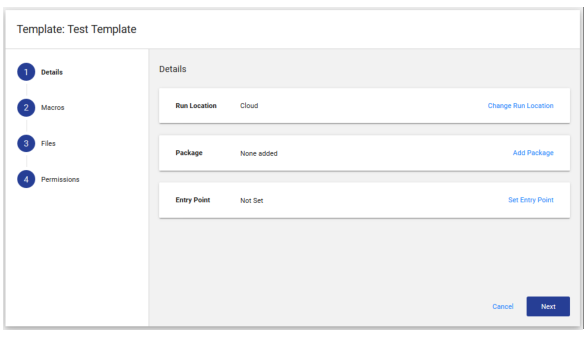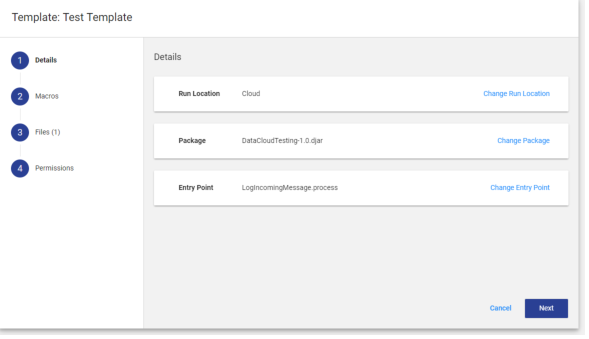Create a Template
Templates represent a reusable configuration with instructions for running your DataConnect job. The template includes a package, macros, and location to execute the job on Actian’s DataCloud or on-premise through an Agent.
To create a template
1. Click the Templates tab.
2. Click the Add button.
3. Enter a name for your template and then click Go.
The template details pane is displayed:
1. Details
1. Specify the following template details:
Run Location
Specify where to run the configuration: in the Cloud or on-premise with an Agent.
Package
a. Select your package by clicking Add Package to open the Select a Package dialog.
b. Click the Upload New Package button to browse for your package locally, then click Add Package.
On-Premise Note: You may use samples provided at C:\Program Files\Actian\IntegrationManager\samples
Entry Point
Set an entry point from the package, then click Save.
Note: The entry point must be a process. If your package only has one entry point, it will be selected automatically.
2. Click Next.
2. Macros
You may either add a macro or import a macro. Follow the appropriate procedure below.
To add a macro
1. Click Macros.
2. Click the Add button, then select Add Macro from the drop-down.
3. Enter the macro name.
4. Provide a value, if needed.
5. If the macro needs to be secured, click the toggle on the right.
6. Click Next.
To import a macro
This method only supports XML and JSON files. For more information about macros and how they are used, see the Actian DataConnect documentation at:
http://docs.actian.com/dataconnect/11.1/index.html.
1. Click Macros.
2. Click Add.
3. Click Import Macro File from the drop-down.
4. Browse for your macro file locally, select the file name, and click Open.
5. Click Next.
3. Files
To add files to the template
1. Click Files.
2. Either drag and drop files onto the Files pane or click Browse Files to browse locally for your files.
4. Permissions
Note: For users who do not have Administrator permissions, the permissions step is grayed out, indicating that permissions may not be changed. Contact your administrator to make changes to your administrative permissions.
To set permissions for groups and users to run the configuration
1. Click Permissions.
2. Assign group permissions by clicking Add, selecting the group from the drop-down, and then clicking Save.
3. Add specific users by clicking Add, selecting the user from the drop-down.
4. Set individual permissions by clicking the toggles for Read, Write, and Run.
5. Click Create Template to finish creating your template.
Not Ready to Finish the Template? If you are not ready to make the template available for configuration runs, you may either delete it or save it as a draft. Click Cancel to choose. Saving as a draft will set the template to inactive. To make it active, in the Templates list, you must click the template name and then click the Active toggle to On. This will make the template active.
You may now add a configuration to your template.





